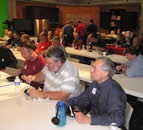News & Headlines
Closed Captioning and the Elimination of POTS Lines
March 4, 2015
The SBE was recently contacted by representatives of the National Court Reporters Association (NCRA) over its concern about the telephone industry's process of phasing out POTS lines. POTS lines are used by many stations to receive closed-caption data. In many cases, this work is performed remotely by members of the NCRA, who are hired by the stations.
The NCRA wants to be sure that TV stations are aware of the phase out of POTS lines and, since it's the station's responsibility to be in compliance with captioning regulations from the FCC, prepare to change to an alternative delivery method. For more information on this topic, the NCRA has provided a short white paper on this subject to the SBE, which follows.
 National Court Reporters Association
National Court Reporters Association
8224 Old Courthouse Road
Vienna, VA 22182-3808
Tel: 703-556-6272
Fax: 703-556-6291
www.ncra.org
Closed Captioning and the Elimination of POTS Lines
The Plain Old Telephone Service (POTS) phone lines serve as the distribution method for a large amount of closed captioning data transmitted in the United States. The captions are generated by the individual broadcast captioner and sent to the television station across POTS lines. The telephone industry's process of eliminating POTS lines has begun a disruption of service pattern across the country. The station as well as the caption provider may not realize data compression within the telephone system is causing garbled captions or intermittent phone drops. While captioners are able to receive audio through VoIP, transmitting captions through VoIP presents significant problems and results in garbled and incorrect captions.
POTS lines are becoming increasingly difficult for consumers to obtain as telephone providers upgrade their equipment to more efficient fiberoptic, digital lines, or VoIP lines as opposed to maintaining existing POTS infrastructure. While POTS may continue in the future for emergency systems, captioners cannot rely on continued access for the foreseeable future. Fiberoptics and other digital lines can transmit caption data successfully; however, these lines are routinely rerouted to long-distance VoIP lines, which then can introduce disruption to the transmission of the caption data.
Caption data cannot be delivered over internet-based telephone systems, or VoIP.
• VoIP compresses the caption data, which damages the captions to the point of making the data unusable on the air. It can also cause random phone line drops.
• POTS lines are the only phone-based system that can reliably deliver caption data.
At this point, POTS lines are being slowly phased out by telephone companies.
• A significant number of television stations rely on POTS lines to receive caption data from their captioners for live and near-live programming such as sporting events and news broadcasts.
• Regardless of market size, television networks and stations need to consider that captioners may not have access to POTS lines.
The onus falls on the broadcaster to ensure that it is in compliance with the captioning regulations from the FCC. Several simple steps can be taken to ensure that captions are successfully delivered to the station using a static IP address.
• All modern caption encoders with HD capability can receive captions through IP delivery.
• If a TV station does not have the option of IP delivery with its current caption encoders, it will need to replace the encoders with equipment that does have the IP delivery option.
• Broadcasters should coordinate the transition to a caption IP-delivery option on their own timeframe, as opposed to one set by the FCC.
For additional information, contact NCRA Director, Government Relations Adam Finkel at afinkel@ncra.org or 703-556-6272 ext. 159.









